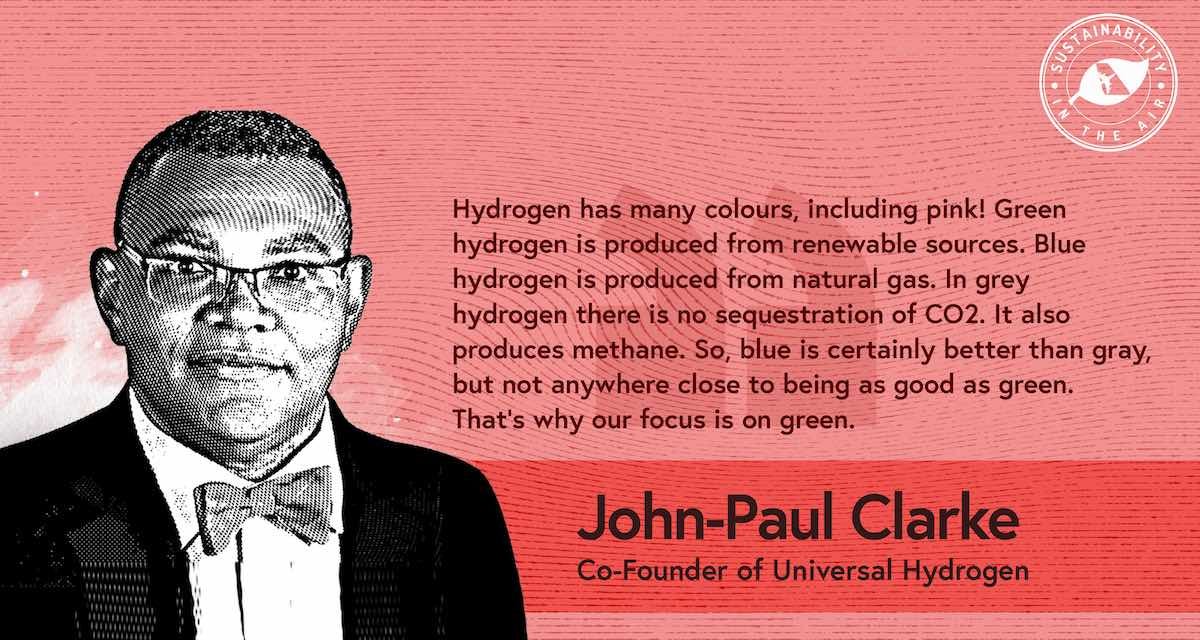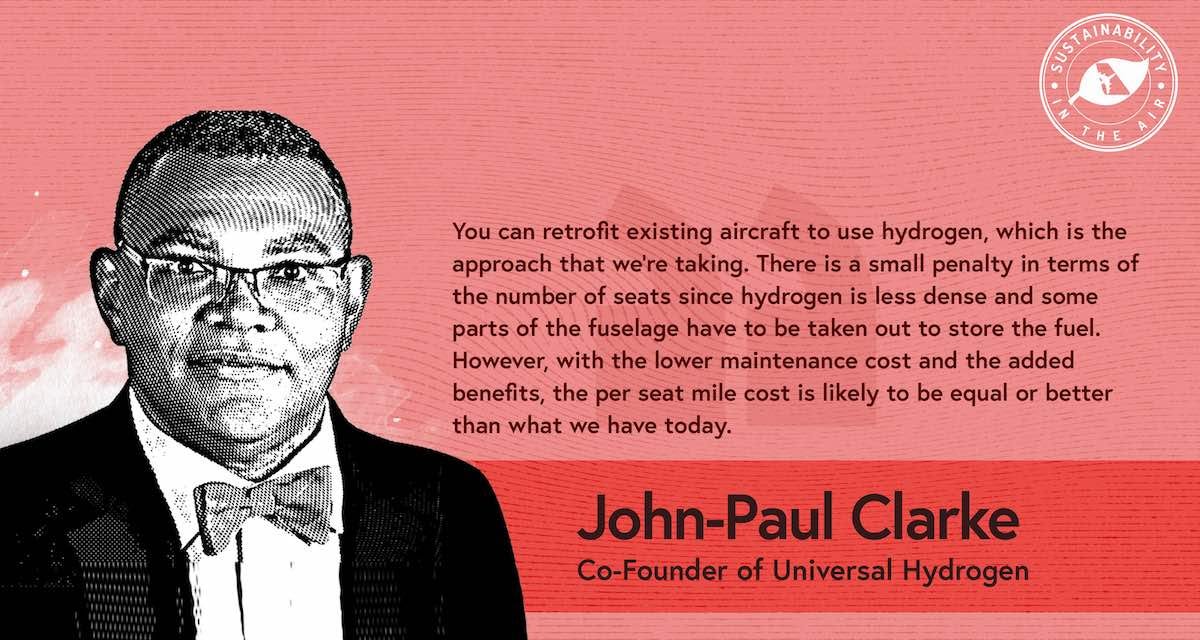Sustainability in the Air is the world’s first podcast dedicated to sustainable aviation. Through in depth conversations with top aviation leaders, we break through the clutter and provide a clear roadmap for a net-zero future.
In this episode of our ‘Sustainability in the Air’ podcast, Universal Hydrogen co-founder, John-Paul Clarke speaks with SimpliFlying CEO, Shashank Nigam, and explains how Hydrogen can help airlines reach their net-zero goals.
You can listen and subscribe to our podcast on all major podcast platforms or read our deep dive into the episode below.
If you’re rushed for time, you can also directly jump to your topic of interest by referring to these time-stamps:
The myriad hues of Hydrogen (3:00)
Green Hydrogen (4:40)
Hydrogen - a feasible solution? (6:20)
How do jet engines work? (10:00)
Overcoming Infrastructure barriers (12:10 & 19:20)
Can existing jets use hydrogen (20:00)
Universal hydrogen’s major partnerships (26:00)
Advice to airline CEOs just starting out with sustainability (33:00)
The myriad hues of Hydrogen
One of the biggest contributors of carbon emissions in aviation is jet fuel. With growing concerns around climate change, airlines are looking for sustainable alternatives. One such clean, zero-emission solution is Hydrogen.
Hydrogen is assigned a colour code based on its method of production. The three types are:
1. Grey Hydrogen: Generated through natural gas and fossil fuels. This also produces CO2 and Methane in the process.
2. Blue Hydrogen: The production is the same as Grey Hydrogen and Carbon Capture and Storage is used to capture and contain the CO2 generated in the process.
3. Green Hydrogen: Uses the process of Electrolysis to generate hydrogen. The electricity required is generated through renewable sources. This is the most expensive of the three options. No Greenhouse Gases (GHGs) are produced in the process.
Universal Hydrogen focuses on the production and dissemination of Green Hydrogen.
Green Hydrogen
At the moment, Green Hydrogen is quite expensive. Clarke remains optimistic that these initial high costs will be brought down by the high demand for the product. He expects that by 2025 it will come at par with Jet fuel on a per seat mile basis.
After the Hindenburg catastrophe, the use of hydrogen as fuel raised quite a few safety concerns. Allaying these fears, Clarke explains that Hydrogen technology has evolved and undergone rigorous testing ever since. It is safe to use and hydrogen can be quickly vented out and readily diluted in case of an accident.
“...we know how to do electrolysis, we’ve been doing it for a long, long time. I mean, I think everybody who’s done high school science will probably remember the experiment where you did a little electrolysis. So it’s not magical. You put electricity to water, and it turns into oxygen and hydrogen”
Hydrogen - a feasible solution?
Universal’s hydrogen technology uses motors and fuel cells due to their low maintenance costs. Hydrogen and Oxygen react in the fuel cell to produce electricity and water. This electricity powers the motor.
Adopting this new system would require certain changes in the aircraft engines. The most significant change, Clarke points out, would be in the engine combustor since hydrogen and jet fuels have different flame speeds and burn properties. If done right, the rest of the components - compressors and turbines, would require minute tweaking.
In Clarke’s opinion, the solution to the sustainability challenge is a combination of SAF and hydrogen technology. For short-haul flights and at the regional turboprop level, hydrogen is the ideal solution but for longer distances SAF is more suited. Clarke also believes that hydrogen will likely be a more competitive and affordable technology than SAF in the long term.
Overcoming Infrastructure barriers
The biggest challenge to scaling hydrogen technology is the lack of adequate and appropriate transportation and airport infrastructure for its transfer. Universal Hydrogen utilises the incumbent infrastructure by using specially designed “modules.” These modules are filled with hydrogen (liquid or gas) and loaded on renewable energy-run trucks or ships or trains to be delivered. On delivery, they are put directly in the aircraft and used when needed. This minimises hydrogen losses since the modules are filled and extracted only once.
The hydrogen modules for the turboprop have two cylinders - one on top of the other, in a frame. The cylinders have several layers to prevent hydrogen leakage, withstand pressure loads and prevent abrasion. The frame that holds these cylinders uses truss structure to withstand crash loads. This design significantly reduces the weight of these modules and makes them easy to transport.
Advice to airline CEOs just starting out with sustainability
Clarke advises airline CEOs, or anyone grappling with sustainability challenges, to keep an open mind. He emphasises the need to understand the fundamentals of the trade and to remember that there isn’t a one-size-fits-all solution to the wicked problem of climate change.
Clarke states that SAF isn’t a silver bullet since it produces soot at high altitudes. He believes that Hydrogen will have an important role to play in achieving net-zero emissions.
Our Take: Innovations & their diffusion
The aviation sector is in dire need of cleaner technologies. Hydrogen as a fuel is a great option as it leaves behind nearly zero emissions. On reaction with oxygen, it leaves behind water vapour at high altitudes which is still better than emitting carbon. However, this game-changing innovation has not been able to find its foot for a long time.
Universal Hydrogen has made significant changes in hydrogen technology. Hydrogen is now manufactured in newer ways using renewable sources and a new delivery system has been set up. Together these two factors have improved how hydrogen can be produced and disseminated. Universal Hydrogen’s process innovation is what gives the technology a competitive edge over the incumbent jet fuel.
The scalability of a technology depends greatly on its adoption in a system. A system may be defined as a network of interlinked actors and their activities. The extent to which a technology finds acceptance in a system is known as the rate of diffusion1. Technological diffusion in the case of Hydrogen has been limited due to infrastructural barriers on the supply side, which drives up its cost.
Another reason why Hydrogen’s rate of diffusion is low is the system’s resistance to change. This inertia keeps the system “locked in” a specific path of development. The incumbent system is entrenched in carbon-intensive technologies and is locked in that pathway.
Universal Hydrogen’s innovation is different and new (“radical innovation”). Government support is essential to fulfill the potential of this innovation. The US Government’s Hydrogen Shot program aims to invest in R&D to slash green hydrogen prices by 80% to just $1 per 1 kilogram by the end of the decade. This is a necessary push in the right direction.
Universal Hydrogen’s commitment to reform Hydrogen technology and, more broadly, the aviation sector is a welcome and necessary change. It provides hope about airlines to reach their net-zero goals by 2030.
Our Sustainability in the Air podcast is powered by SimpliFlying which has been helping build trust in travel for over a decade.
This season of the podcast is brought to you by CarbonClick, leaders in managing carbon offsetting programs for top global airlines.
Fagerberg, J. (2006). Innovation: A Guide to the Literature. Oxford Handbooks Online. Oxford University Press. doi:10.1093/oxfordhb/9780199286805.003.0001.














